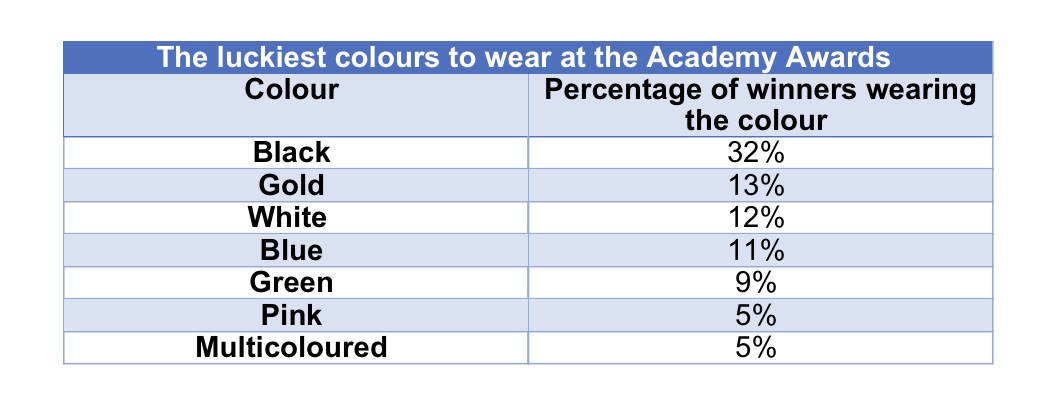This is the ‘luckiest dress’ to wear to the Oscars, new study reveals

New study reveals the luckiest colours and designers to wear to the Oscars to increase nominee’s chances of winning.
The research conducted by fabric experts Dalston Mill Fabrics analysed every dress or outfit worn by each winner of a ‘Best Actress’ and ‘Best Supporting Actress’ Academy Award in recorded history, to establish whether the colour and designer of a dress can affect the chances of taking home a coveted Oscar.
The research revealed that black is the luckiest colour to wear to the Academy Awards. Wearing black could increase the chances of winning an Oscar by almost a third, as 32% of ‘Best Actress’ and ‘Best Supporting Actress’ category winners have dressed in black to accept their awards in history. Noteworthy examples include Cher’s iconic sheer 1988 Bob Mackie gown and Frances McDormand’s 2021 black Valentino dress.
Designers Giorgio Armani and Valentino rank as the joint luckiest fashion houses to wear on the red carpet, so pair these with the colour black for the luckiest dresses to increase nominee’s chances of taking home an Academy Award.
The study revealed that 13% of female winners in recorded history wore a variation of the colour gold, making it the second luckiest colour to wear to the Academy Awards. For instance, recent success stories include Emma Stone, who took home the ‘Best Actress’ award for La La Land in 2017 while dressed in a gold Givenchy Haute Couture design. Gold is currently the luckiest colour to wear to the Academy Awards in the 21st century, with 20% of leading female winners wearing gold as opposed to 14% choosing black.
With 12% of winners wearing the colour, the third-luckiest colour to wear to the Academy Awards is white. Most notably, Audrey Hepburn famously referred to the gown she wore to collect her first ‘Best Actress’ award in 1954 as her “lucky dress” – a white Givenchy gown adapted from her Roman Holiday costume.
The fourth luckiest colour to wear to the Oscars is blue, with 11% of all past winners wearing the colour, and green ranks fifth, with 9%.
The research also revealed the luckiest fashion designers to wear to the Oscars. Giorgio Armani and Valentino share the crown as the joint luckiest fashion houses, with 7% of Oscar winners in history having worn Armani and Valentino whilst collecting their Academy Awards.
The 92nd Academy Awards was an especially lucky year to wear Georgio Armani, with both female winners in an acting category wearing Armani on the red carpet. Winner of ‘Best Actress’ Renée Zellweger wore an Armani Privé white one-shouldered gown, while Laura Dern, winner of ‘Best Supporting Actress,’ wore a pink Armani satin dress with a tasselled black upper.
In recent years, Frances McDormand has won two ‘Best Actress’ Oscars while wearing Valentino, while Cate Blanchett also won her first Academy Award sporting the Italian fashion house. The most recent example is last year’s winner Ariana DeBose, who won her ‘Best Supporting Actress’ Oscar for West Side Story while dressed in Valentino.
Fashion designers such as Yves Saint Laurent, Chanel, Christian Dior and Gucci all also rank as lucky designers to wear to the Academy Awards, with 3% each of winning ladies wearing their dresses to collect Oscars.
A spokesperson for Dalston Mill Fabrics commented on the findings: “As the most anticipated event in the Hollywood calendar nears, the Oscars are the perfect night for A-Listers to showcase their most fashionable red carpet looks. This research highlights that almost a staggering third of all winners in a female acting category have dressed in black to accept their Academy Awards, since the Oscars first began in 1929.
From extravagant ballgowns to little black dresses, wearing black is a fashion classic that has evidently stood the test of time. The study suggests that wearing a black Armani or Valentino dress is the perfect winning formula for hopeful nominees, which will not only increase their likelihood of winning an Academy Award but also offer a timeless and elegant look for the red carpet.”
The study was conducted by Dalston Mill Fabrics, a London based fabric sellers that offer a wide variety of fabrics and materials.






